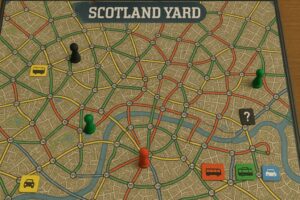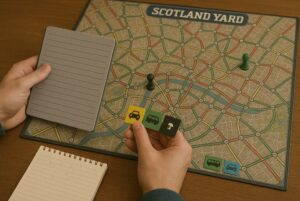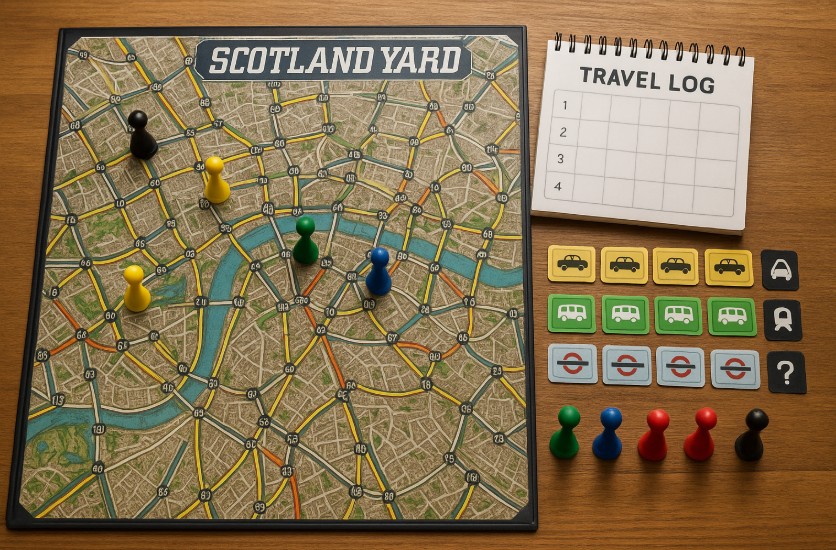The Scotland Yard board game is a classic example of strategic deduction and cooperative gameplay. Set on the streets of London, it challenges players to work together as detectives to capture the elusive Mr. X.
Since its release in 1983, it has earned acclaim for its unique mechanics, engaging gameplay, and timeless appeal. This guide explores the game’s rules, setup, and strategic depth, making it an essential read for both new players and seasoned board game enthusiasts.
What Is the Scotland Yard Board Game and Why Is It So Popular?

Scotland Yard is a detective-themed board game set in the heart of London. Designed to offer players a mix of strategy, deduction and team collaboration, it places one player in the role of a fugitive (Mr. X) and the rest as detectives trying to capture him.
First published in 1983 by Ravensburger, it was widely praised for its innovative gameplay and won the Spiel des Jahres award the same year.
The appeal lies in its asymmetrical gameplay. While most players work together as detectives, one player operates alone, evading capture using hidden movements. This concept was fresh at the time and helped the game stand out among classic board games in the UK and beyond.
Its continued popularity is largely due to its simplicity, engaging strategy and the excitement of deduction. The suspense created by hidden movements and periodic reveals keeps all players alert and involved throughout the game.
How Is the Scotland Yard Board Game Set Up?
Setting up the game involves laying out the central London map board, which features 199 interconnected stations. Players then draw start cards to determine the initial positions of their tokens. Mr. X keeps their location hidden, while detectives openly place their pawns on their respective starting stations.
The box contents include:
- Game board with a detailed map of London
- 6 coloured playing pieces (for 5 detectives and Mr. X)
- 130 transportation tickets (taxi, bus, underground, black)
- 29 starting cards
- 3 double-move tokens
- Travel log with paper inserts
- Storage tray and labels
Depending on the version, there are slight variations in setup. The 1985 Milton Bradley edition and the 2013 Ravensburger version differ in their number of tickets, the division of start cards, and the introduction of additional mechanics like the “bobbies,” which act as ticket-free detectives controlled by player consensus.
What Are the Main Objectives and Roles in the Game?
Each player’s role defines their objective and how they interact with the game board. The game is structured as a race between detection and evasion.
Mr. X’s objective is to avoid capture for the entire game. Using hidden movements and special tickets, they must stay ahead of the detectives.
The detectives’ objective is to land on the same station as Mr. X or block all his possible moves by coordinating their efforts and using deduction.
In games with fewer than six players, unused detective pawns can be turned into “bobbies,” who do not require transport tickets and are moved by player consensus.
Win conditions for each side are clear:
| Role | Win Condition |
| Mr. X | Avoid capture until detectives run out of moves |
| Detectives | Land on Mr. X’s space or block all movement options |
This structure creates an engaging balance between stealth and strategy.
How Does Movement Work in the Scotland Yard Board Game?

Movement in Scotland Yard is based on London’s transport network and uses tickets to simulate travel across taxi, bus, underground and ferry routes.
Each station is connected via one or more transportation modes. Players move by spending a ticket corresponding to the available connection. Movement options depend on the station’s location and the transport lines connected to it.
Types of transport and their movement range:
| Transport Mode | Ticket Colour | Movement Distance | Available To |
| Taxi | Yellow | One station | All players |
| Bus | Green | Medium distance | All players |
| Underground | Red | Long distance | All players |
| Ferry | Black | Thames route | Mr. X only |
Detectives start with a limited number of each ticket type. Mr. X receives the remaining tickets and accumulates all used detective tickets during play, gaining unlimited travel resources over time.
Mr. X also has:
- Black tickets, which conceal the transport type used
- Double-move tokens, which allow two moves in one turn
These mechanics make Mr. X’s movement highly unpredictable, challenging the detectives to anticipate his path through logical reasoning and collective deduction.
How Does Mr. X Stay Hidden During the Game?
The hidden movement mechanic is central to Scotland Yard’s gameplay. Mr. X does not place their token on the board except during specific reveal rounds. Instead, their moves are logged on a special travel log using paper inserts.
Each entry in the log corresponds to a turn, and the player records the station number reached along with the ticket used. This is done secretly, with the ticket physically placed over the destination number to obscure it.
Mr. X reveals their location at five specific turns, providing the detectives a chance to close in. These turns are predetermined, and special slots in the travel log act as reminders. After revealing, Mr. X removes their pawn again and continues in secret, unless a double move is triggered.
The mechanics include:
- Recording each move on the travel log
- Using transport tickets to cover destination numbers
- Revealing position at rounds 3, 8, 13, 18, and 24
- Double moves logged with two separate entries
Detectives must rely on these limited reveals and the types of tickets used to triangulate Mr. X’s position and anticipate future moves.
What Strategy Tips Can Help You Win the Scotland Yard Board Game?

Scotland Yard is a game where success hinges on smart planning, sharp observation, and the ability to adapt quickly. Whether you’re taking on the role of Mr. X or joining the team of detectives, understanding key strategies can significantly increase your chances of winning.
Strategy Tips for Playing as Mr. X
As the sole hidden player, Mr. X must stay one step ahead of the detectives. The goal is not only to avoid capture but also to create enough confusion that the detectives misread your intentions. Several tactics can help you achieve this:
- Make Use of High-Connectivity Stations: Stay near areas on the board where multiple types of transportation intersect—these hubs allow for more movement options and make your trail harder to follow. Locations with access to taxis, buses, and underground lines are particularly useful for quick diversions.
- Plan Around the Reveal Rounds: The five turns when you must reveal your position are critical. Leading up to these turns, position yourself in a way that allows multiple escape routes. Ideally, you should plan at least two or three turns ahead so that you’re not cornered once your location becomes known.
- Use Black Tickets to Disrupt Detective Deduction: Black tickets allow you to move using any transportation method without revealing which one was used. These are invaluable for misleading detectives, especially after a reveal. A black ticket can make them think you’ve taken the underground when you’ve really used a taxi.
- Save Double-Move Tokens for Emergencies: Double moves let you make two moves in a single turn. These are best used either immediately after a reveal or when you sense you’re close to being surrounded. Moving twice in quick succession can throw off the detectives’ deduction patterns, giving you a vital head start.
- Avoid Backtracking or Obvious Loops: Once the detectives get a sense of your movement pattern, they will start predicting your next steps. Avoid making predictable loops or returning to previously used stations. Stay unpredictable and mix your route often.
- Travel Close to the Detectives—Sometimes: Counterintuitively, sometimes the safest place to be is near your pursuers. If the detectives believe you’ve fled across the board, hiding just a few spaces away can keep you safe. Just be cautious not to get boxed in.
Strategy Tips for Playing as the Detectives
Detectives need to function as a team. Communication, logical thinking, and spatial awareness are essential. The detectives can only win by working together to outsmart Mr. X.
- Spread Out Strategically, Not Randomly: At the start of the game, detectives should avoid clustering together. Spreading out ensures a wider area is covered and increases the chance of intercepting Mr. X’s trail. However, this distribution should be deliberate—spread in a way that controls access to underground hubs and bus lines.
- Track the Tickets Used by Mr. X: Each turn, detectives see the transport ticket Mr. X used. This information is crucial. A bus ticket narrows the possibilities to stations connected via green lines. Keeping a visual or written record of the ticket history can guide your predictions.
- Use the Reveals to Box In Mr. X: During a reveal, when Mr. X must show his location, detectives should not all rush to the revealed space. Instead, they should attempt to block the most likely escape routes using the limited number of moves they have. The goal is to create a containment perimeter.
- Coordinate Movement Carefully: Since Mr. X moves first every round, detectives can’t catch him simply by chasing directly behind. Instead, they must think ahead. Try to position pawns in such a way that forces Mr. X into limited areas where escape becomes increasingly difficult.
- Use Taxis More Often in Crowded Zones
In the central parts of the board where stations are dense, using taxis allows more granular control over movement. This can be especially useful when trying to corner Mr. X in a tight area where underground or bus stations are sparse. - Don’t Waste Tickets: Tickets are limited for each detective. Using too many underground or bus tickets early in the game can leave a player stranded in the late stages. Maintain a balance of ticket types and conserve underground tickets for critical mid- or late-game movement.
- Be Willing to Sacrifice a Detective’s Position: Sometimes it’s worth placing a detective in a remote or strategically limited area simply to block an escape route. Even if that player won’t move for a few turns, their presence can restrict Mr. X’s options significantly.
- Track Common Hiding Areas: Experienced players know that Mr. X often favours areas near the Thames or station-dense zones like the West End. Keeping one or two detectives hovering near these zones can pay off, particularly after a reveal.
- Communicate Constantly: Open discussion is key. Share your thoughts on where Mr. X might be, your planned movements, and what others should avoid doing. The more coordinated the detectives are, the less room Mr. X has to escape unnoticed.
Common Mistakes to Avoid
For Mr. X:
- Using black tickets too frequently, which can cause suspicion
- Relying on underground too often, making patterns easier to predict
- Staying in remote zones where movement options are limited
For Detectives:
- Failing to plan beyond one turn
- Overusing high-value tickets too early
- Clumping together and missing key areas of the board
Both sides must play with a mix of caution and calculated risk. While luck plays a minor role in start positions and draws, Scotland Yard heavily rewards players who think spatially and adapt based on the other side’s actions.
Would you like to generate an image for this section? If so, let me know what kind of visual representation you’d prefer.
How Do the Different Editions of Scotland Yard Compare?
There are subtle but important differences between the Milton Bradley and Ravensburger editions that affect game dynamics, particularly in components and station numbering.
Key comparisons between the two editions:
| Feature | Milton Bradley (1985) | Ravensburger (2013) |
| Taxi Tickets | 54 | 57 |
| Bus Tickets | 43 | 45 |
| Underground Tickets | 23 | 23 |
| Black Tickets | 5 | 5 |
| Double-Move Tokens | 2 | 3 |
| Starting Cards | Shared (18 total) | Separate (29 total) |
| Bobby Mechanics | Not available | Included |
| Station Numbering Differences | Yes | Yes |
| Notable Missing Station Numbers | Ravensburger: 200 | Milton Bradley: 108 |
In the Ravensburger edition, the game also introduces updated rules for gameplay with fewer players, allowing use of “bobbies” to maintain balance.
Some of the transport connections were also revised in the updated version. For example, certain routes between high-numbered stations changed from bus lines to taxi lines, affecting movement strategies in those zones.
Is Scotland Yard Suitable for Families and Casual Gamers?
The cooperative structure and clear rules make Scotland Yard a suitable choice for families and casual players alike. Its hidden movement mechanic is easy to understand but provides enough complexity to keep gameplay engaging over multiple sessions.
Scotland Yard works best with 3 to 6 players. With fewer players, shared detective roles or the inclusion of bobbies help maintain the tension and pace.
Key aspects that make the game accessible include:
- Simple rules and visual indicators for movement
- Cooperative detective play fostering communication
- No need for reading lengthy instructions
- Quick setup and average playtime of under one hour
Its approachable mechanics make it a great gateway game for those new to board gaming, while still offering enough depth for experienced players looking for strategic deduction.
How Does Scotland Yard Compare to Other Detective Board Games?

While Scotland Yard is not the only hidden movement game available, it has maintained its popularity due to its streamlined gameplay and thematic appeal. Other games in the same genre often add more layers of complexity or thematic elements.
Comparison with similar games:
| Game Title | Style | Key Features |
| Scotland Yard | Hidden movement, co-op | Periodic reveals, simple transport-based deduction |
| Letters from Whitechapel | Historical, hidden move | Based on Jack the Ripper, more complex tracking |
| Fury of Dracula | Horror theme, combat | Includes battles, character abilities, and items |
Scotland Yard’s strength lies in its accessibility and the sheer enjoyment of deduction. Unlike its counterparts, it focuses solely on the chase, without adding too many mechanics, which keeps it fast-paced and beginner-friendly.
Conclusion
Scotland Yard continues to be a beloved classic for good reason. Its unique blend of deduction, stealth, and cooperative strategy offers a gaming experience that few other board games can match. Whether you’re evading as Mr. X or closing in as a detective, every round presents a fresh challenge.
With easy-to-understand rules, a reasonable playtime, and high replayability, it’s ideal for game nights, families, and new players looking to explore strategic board games.
FAQs About the Scotland Yard Board Game
What is the minimum age for playing Scotland Yard?
Scotland Yard is recommended for players aged 10 and above due to its strategic nature and reliance on deduction and planning.
How long does a typical game of Scotland Yard last?
A standard game takes approximately 45 to 60 minutes, depending on the number of players and their familiarity with the rules.
Can Scotland Yard be played with only two players?
Yes, the game allows for 2-player gameplay, with one player as Mr. X and the other controlling all detective roles, though it’s more dynamic with 3 or more players.
What makes Scotland Yard different from other board games?
The hidden movement mechanic and asymmetric gameplay are what set Scotland Yard apart, offering a thrilling game of deduction and pursuit.
Are there digital or app versions of Scotland Yard?
Yes, digital versions are available for iOS and Android, featuring AI opponents and online multiplayer capabilities.
How many times does Mr. X reveal their position?
Mr. X reveals their position five times during the game, giving detectives a chance to coordinate their pursuit efforts.
Is the Scotland Yard board game good for beginners?
Yes, it’s a great starting point for those new to strategic or cooperative board games. The rules are simple, and the gameplay is intuitive.







